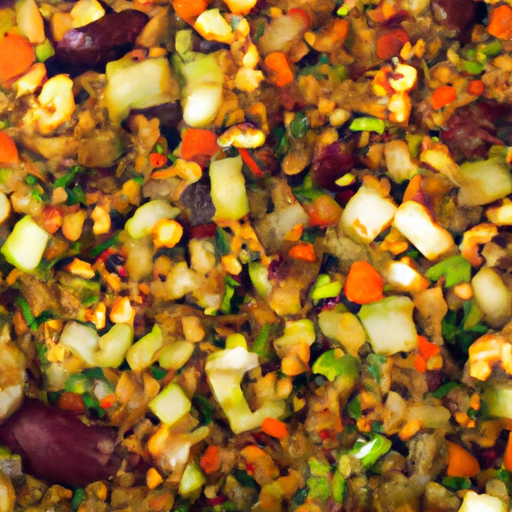Meat-Free Crumbles: A Versatile and Delicious Addition to Your Kitchen
If you’re looking to incorporate more plant-based options into your diet without sacrificing taste and texture, meat-free crumbles are a fantastic choice. These versatile protein-packed crumbles mimic the texture and flavor of traditional meat, making them perfect for a wide range of dishes. In this blog post, we’ll dive into the world of meat-free crumbles, exploring their taste, common uses in cooking, nutritional value, and uncover some interesting history and facts.
The Taste of Meat-Free Crumbles
Meat-free crumbles are carefully crafted to provide a satisfying taste and texture that closely resembles meat. Made from plant-based ingredients such as soy, mushrooms, or legumes, these crumbles are expertly seasoned to deliver a savory umami flavor. Whether you’re a dedicated vegetarian, vegan, or simply looking to include more plant-based options in your diet, meat-free crumbles are sure to impress your taste buds.
Common Uses in Cooking
Meat-free crumbles are incredibly versatile, making them a go-to ingredient in countless recipes. They can be used as a direct replacement for ground meat in traditional dishes, such as tacos, chili, pasta sauces, meatballs, and even meatloaf. The crumbles blend effortlessly with other ingredients, absorbing flavors from herbs, spices, and sauces, resulting in a delicious, well-rounded dish. With meat-free crumbles, you can recreate your favorite meat-based recipes with a plant-based twist, satisfying your cravings and nourishing your body.
Nutritional Value
Apart from their mouthwatering taste and ability to mimic traditional meat, meat-free crumbles offer numerous health benefits. They are an excellent source of plant-based protein, fiber, and essential vitamins and minerals. Compared to their meat counterparts, meat-free crumbles typically contain less saturated fat and cholesterol, making them a heart-healthy choice. Additionally, by opting for plant-based alternatives, you contribute to reducing your carbon footprint and promoting a more sustainable food system.
Interesting History and Facts
While the popularity of meat-free crumbles has skyrocketed in recent years, their origins can be traced back decades. Meat substitutes, including crumbles, have been consumed in various cultures for centuries. In ancient China, tofu was used as a plant-based alternative to meat, and in the Mediterranean, legumes and mushrooms were often blended to create hearty dishes reminiscent of meat. Today, meat-free crumbles have taken this concept to new heights, using innovative techniques and ingredients to replicate the taste and texture of meat more accurately than ever before.
Fun fact: Meat-free crumbles have become so popular that even traditional meat companies have started producing their own plant-based alternatives to remain competitive in the ever-growing market of plant-based proteins.
Conclusion
Meat-free crumbles are a game-changer for those looking to explore the world of plant-based cooking. With their incredible taste, versatility in cooking, and impressive nutritional profile, it’s no wonder they’ve become a kitchen staple for vegetarians, vegans, and flexitarians alike. So why not give meat-free crumbles a try? Experiment with different recipes, enjoy the benefits they provide for your health and the environment, and embark on a delicious culinary journey that celebrates the best of both the plant and animal kingdoms.
Meat Free Crumbles
Origin: Meat free crumbles, also known as meat substitutes or meat analogues, have been gaining popularity in recent years as a plant-based alternative to traditional ground meat. The concept of meat substitutes has been around for centuries, with tofu, tempeh, and seitan being some of the earliest examples. However, modern meat free crumbles, made from ingredients like soy, wheat gluten, or legumes, have emerged as a result of advances in food technology and increased interest in plant-based diets.
Common Uses: Meat free crumbles are versatile and can be used in a variety of dishes. They are often used as a substitute for ground meat in recipes such as chili, tacos, burgers, meatballs, and pasta sauces. Some people also use them to make vegetarian or vegan versions of popular dishes like shepherd’s pie or meatloaf.
Nutritional Benefits: Meat free crumbles can be a valuable source of protein for individuals following a plant-based diet or looking to reduce their meat consumption. Different brands and varieties vary in nutritional composition, but many meat free crumbles provide a good amount of protein, fiber, and essential nutrients like iron and B vitamins. They are generally lower in saturated fat and cholesterol compared to traditional ground meat.
Unique Properties and Historical Significance: Meat free crumbles have revolutionized the vegetarian and vegan food market by providing a texture and taste similar to ground meat, allowing individuals to enjoy familiar dishes without using animal products. This has made plant-based eating more accessible and appealing to a wider audience. The availability of meat substitutes has grown significantly in recent years, reflecting a changing food landscape and increased consumer demand for alternatives to animal-based products.
It’s worth noting that the use of meat substitutes is not a recent development. In various cultures around the world, dishes have been created using plant-based ingredients that mimic the appearance and taste of meat. For example, in Chinese cuisine, tofu has been used for centuries to simulate the texture and flavor of fish, chicken, and pork. These historical examples highlight the long-standing desire of individuals to create meat-like alternatives using plant-based sources.




Use the share button below if you liked it.
It makes me smile, when I see it.